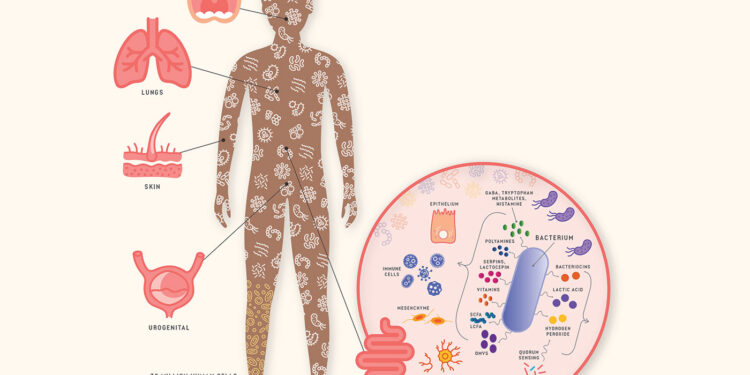Human cells make up only 43% of the body’s total cell count. The rest are microscopic colonists. Understanding this hidden half of ourselves – our microbiome – is rapidly transforming our understanding of diseases from allergy to Parkinson’s.The field is even asking questions of what it means to be “human” and is leading to new innovative treatments as a result.
A 2016 study refined earlier estimates and found that the human body has roughly 30 trillion human cells and about 39–40 trillion microbial cells (including bacteria, viruses, and fungi). This means microbes slightly outnumber human cells, but the ratio is much closer to 1:1 rather than the previously believed 10:1 or 70:1.
“They are essential to your health,” says Prof Ruth Ley, the director of the Department of Microbiome Science at the Max Planck Institute, “your body isn’t just you”
- No matter how well you wash, nearly every nook and cranny of your body is covered in microscopic creatures.This includes bacteria, viruses, fungi and archaea (organisms originally misclassified as bacteria). The greatest concentration of this microscopic life is in the dark murky depths of our oxygen-deprived bowels.
Prof Rob Knight, from University of California San Diego, told the BBC: “You’re more microbe than you are human.”
- Originally it was thought our cells were outnumbered 10 to one.”That’s been refined much closer to one-to-one, so the current estimate is you’re about 43% human if you’re counting up all the cells,” he says. But genetically we’re even more outgunned.
- The human genome – the full set of genetic instructions for a human being – is made up of 20,000 instructions called genes. But add all the genes in our microbiome together and the figure comes out between two and 20 million microbial genes.
Prof Sarkis Mazmanian, a microbiologist from Caltech, argues: “We don’t have just one genome, the genes of our microbiome present essentially a second genome which augment the activity of our own.
While the idea that our bodies are 70% bacteria is a common misconception, it’s more accurate to say that microbes (including bacteria, fungi, and viruses) outnumber human cells, but not by a factor of 70%. Scientific American reports that microbes and human cells are roughly in a 1:1 ratio, Nature reports that the average human body contains about 40 trillion bacteria and 30 trillion human cells

A visually striking representation of the human body made up of two distinct types of cells. One part of the body (about 43%) is formed from human cells, glowing slightly to indicate their structured nature. The rest (about 57%) consists of microbial cells, depicted as a swirling, colorful cloud of bacteria, viruses, and other microbes, emphasizing their diversity and importance. The image should have a scientific yet artistic look, resembling a fusion of biology and data visualization.



